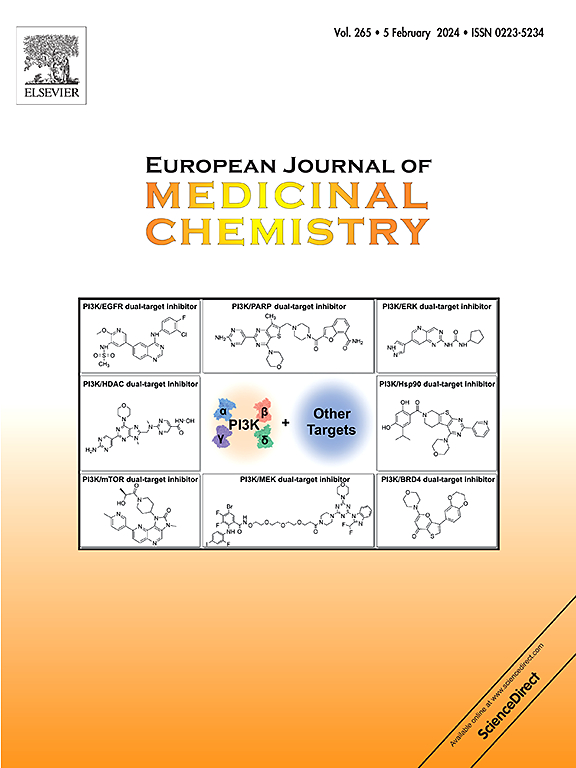Targeting voltage-gated proton channel HV1: Optimised 5-phenyl-2-aminoimidazoles with anticancer potential
IF 6
2区 医学
Q1 CHEMISTRY, MEDICINAL
引用次数: 0
Abstract
The voltage-gated proton channel (HV1) has been linked to the development of tumours, neuroinflammatory diseases, immune disorders and infertility, making HV1 inhibitors promising candidates for therapeutic development. In this study, we designed and synthesized an optimised series of 5-phenyl-2-aminoimidazole-based HV1 inhibitors, with the most potent compounds exhibiting low micromolar IC50 values. Structural analysis highlighted the importance of an unsubstituted 2-aminoimidazole core and flexible linkers for optimal ligand-channel binding, driven by hydrogen bonding and hydrophobic interactions. Antiproliferative assays showed that the most potent HV1 inhibitors had IC50 values in the low micromolar range, with greater efficacy against THP-1 cells (human monocytic leukaemia), which express HV1 at high levels, compared to MCF-7 cells (human breast cancer) with lower HV1 expression. The type II compounds exhibited superior drug-like properties, including improved solubility, plasma protein binding and permeability compared to previous 5-phenyl-2-aminoimidazole-based HV1 inhibitors, as well as robust metabolic stability. However, selectivity over the KV1.3 and NaV1.5 channels remained limited. This work advances the development of HV1 inhibitors. It provides valuable chemical tools to study the role of HV1 in disease pathogenesis and lays the foundation for new therapeutic strategies targeting HV1-mediated signalling pathways.


靶向电压门控质子通道HV1:具有抗癌潜力的优化5-苯基-2-氨基咪唑
电压门控质子通道(HV1)与肿瘤、神经炎性疾病、免疫紊乱和不育症的发展有关,使HV1抑制剂成为治疗开发的有希望的候选者。在这项研究中,我们设计并合成了一系列优化的基于5-苯基-2-氨基咪唑的HV1抑制剂,其中最有效的化合物具有低微摩尔IC50值。结构分析强调了未取代的2-氨基咪唑核和柔性连接体对于由氢键和疏水相互作用驱动的最佳配体通道结合的重要性。抗增殖试验表明,最有效的HV1抑制剂在低微摩尔范围内具有IC50值,与低HV1表达的MCF-7细胞(人乳腺癌)相比,对高水平表达HV1的THP-1细胞(人单核细胞白血病)具有更大的疗效。与之前的5-苯基-2-氨基咪唑类HV1抑制剂相比,II型化合物具有优异的药物样特性,包括改善的溶解度、血浆蛋白结合和渗透性,以及强大的代谢稳定性。然而,KV1.3和NaV1.5通道的选择性仍然有限。这项工作促进了HV1抑制剂的发展。它为研究HV1在疾病发病机制中的作用提供了有价值的化学工具,并为针对HV1介导的信号通路的新治疗策略奠定了基础。
本文章由计算机程序翻译,如有差异,请以英文原文为准。
求助全文
约1分钟内获得全文
求助全文
来源期刊
CiteScore
11.70
自引率
9.00%
发文量
863
审稿时长
29 days
期刊介绍:
The European Journal of Medicinal Chemistry is a global journal that publishes studies on all aspects of medicinal chemistry. It provides a medium for publication of original papers and also welcomes critical review papers.
A typical paper would report on the organic synthesis, characterization and pharmacological evaluation of compounds. Other topics of interest are drug design, QSAR, molecular modeling, drug-receptor interactions, molecular aspects of drug metabolism, prodrug synthesis and drug targeting. The journal expects manuscripts to present the rational for a study, provide insight into the design of compounds or understanding of mechanism, or clarify the targets.

 求助内容:
求助内容: 应助结果提醒方式:
应助结果提醒方式:


